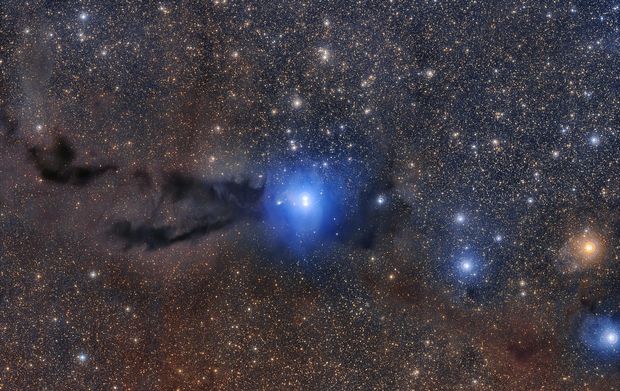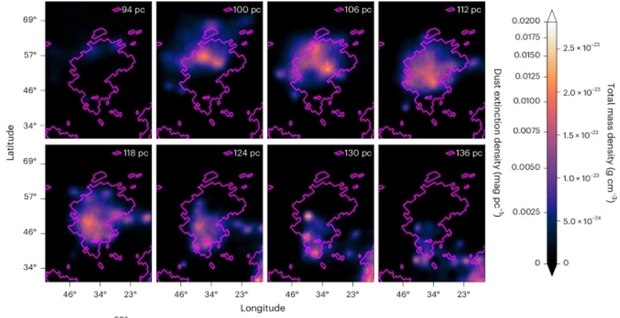We don’t talk about the interstellar medium as much as we ought to. After all, if a central goal of our spacefaring is to probe ever further into the cosmos, we’re going to need to understand a lot more about what we’re flying through. The heliosphere is being mapped and we’ve penetrated it with still functioning spacecraft, but out there in what we can call the local interstellar medium (LISM) and beyond, the nature of the journey changes. Get a spacecraft up to a few percent of the speed of light and we have to think about encounters with dust and gas that affect mission design.
Early thinking on this was of the sort employed by the British Interplanetary Society’s Project Daedalus team, working their way through the design of a massive two-staged craft that was intended to reach Barnard’s Star. Daedalus was designed to move at 12 percent of lightspeed, carrying a 32 meter beryllium shield for its cruise phase. Designer Alan Bond opined that the craft could also deploy a cloud of dust from the main vehicle to vaporize enroute particles before they could reach the shield.
Other concepts for dust mitigation have included using beamed energy to deflect larger objects, or in the case of micro-designs like Breakthrough Starshot, simply turning the craft to present as little surface area along the path of flight as possible, acknowledging that there is going to be an attrition rate in any swarm of outgoing probes. Send enough probes, in other words, and a workable percentage of them should get through.

Image: A dark cloud of cosmic dust snakes across this spectacular wide field image, illuminated by the brilliant light of new stars. This dense cloud is a star-forming region called Lupus 3, where dazzlingly hot stars are born from collapsing masses of gas and dust. This image was created from images taken using the VLT Survey Telescope and the MPG/ESO 2.2-metre telescope and is the most detailed image taken so far of this region. Credit: ESO/R. Colombari.
However we manage it, dust mitigation appears essential. Dana Andrews once calculated that for a starship moving at 0.3 c, a tenth of a micron grain of typical carbonaceous dust would have a relative kinetic energy of 37,500,000 GeV.. So understanding what’s around us, and in particular the gas and dust environment beyond but near the Solar System, is essential for future probes. For those wanting to brush up, the best overview on the interstellar medium remains Bruce Draine’s Physics of the Interstellar and Intergalactic Medium (Princeton, 2010).
Of course, most of the interstellar medium is made up of gas rather than dust, at a ratio of something like 99 to 1. The dust effect can be catastrophic, but the presence of this hydrogen and helium has been invoked by people like Robert Bussard because it could theoretically provide fuel to an interstellar ramscoop craft. Current thinking leans away from the idea, but it’s interesting to learn that we have sources of hydrogen far larger than we realized and also much closer to the Sun than, say, the Orion Nebula.

Thus my interest in a new paper out of Rutgers University. An international team working with astrophysicist Blakesley Burkhart has identified a hitherto unobserved cloud that could one day spawn new stars. Composed primarily of molecular hydrogen and dust, along with carbon monoxide, the cloud emerged in studies at far-ultraviolet wavelengths. The discovery is unusual because it is difficult to observe molecular hydrogen directly. Most observations of such clouds have to employ radio and infrared data, where the signature of CO is a clear tracer of the mass of molecular hydrogen.
Image: Blakesley Burkhart, a Rutgers University astrophysicist, has led a team that discovered the molecular hydrogen gas cloud, Eos. Credit: Rutgers University.
The data for this work were collected by FIMS-SPEAR (fluorescent imaging spectrograph), a far-ultraviolet instrument aboard the Korean satellite STSAT-1. Named Eos, the new cloud turns out to be one of the largest single structures in the sky. It is located some 300 light years away at the edge of the Local Bubble, and masses about 3400 times the mass of the Sun. The Solar System itself resides within the Local Bubble, which is several hundred parsecs in diameter and was probably formed by supernovae that created a hot interior cavity now surrounded by gas and dust. The nearby star-forming regions closest to the Sun are found along the surface of this bubble.
If we could see it with the naked eye, Eos would measure about forty moons across the sky. The likely reason it has not been detected before is that it is unusually deficient in carbon monoxide and thus hard to find with more conventional methods. Says Burkhart:
“This is the first-ever molecular cloud discovered by looking for far ultraviolet emission of molecular hydrogen directly. The data showed glowing hydrogen molecules detected via fluorescence in the far ultraviolet. This cloud is literally glowing in the dark.”
And getting back to dust, this work usefully shows us how we’re beginning to map relatively nearby space to locate concentrated areas of such matter. From the paper:
Using Dustribution [a 3D dust mapping algorithm], we compute a 3D dust map of the solar neighbourhood out to a distance of 350 pc. Figure 3 [below] shows the reconstructed map, focusing on the region of the Eos cloud as a function of distance. We see a single, distinct cloud that corresponds to the H2 emission stretching from 94 to 130 pc; no other clouds are visible along the same lines of sight in Fig. 3. This establishes the cloud as among the closest to our Solar System, on the near side of the Sco–Cen OB association [Scorpius–Centaurus Association, young stars including the Southern Cross formed from the same molecular cloud]…

Image: This is part of Figure 3 from the paper. Caption: 3D dust density structure of the Eos cloud. Two-dimensional slices of the cloud at different distances. The colour bar indicates both the total dust extinction density and the total mass density, assuming dust properties from ref. 29 and a gas-to-dust mass ratio of 124… [T]he magenta contour shows the region with high H2/FUV ratio. Credit: Burkhart et al.
And I quite like this video the scientists have put together illustrating the cloud and its relationship to the Solar System.
Image: Scientists have discovered a potentially star-forming cloud and called it “Eos.” It is one of the largest single structures in the sky and among the closest to the Sun and Earth ever to be detected. Credit: Thomas Müller (HdA/MPIA) and Thavisha Dharmawardena (NYU).
The paper is Burkhart et al., “A nearby dark molecular cloud in the Local Bubble revealed via H2 fluorescence,” Nature Astronomy 28 April 2025). Full text.



Maybe in the distant future, a solar system with life will form from the collapsing of this cloud.
Astronomers have a tendency to use Rube Goldberg units. ‘37,500,000 GeV’ is 37.5 PeV, or 3.75e+16 eV. But one eV is just 1.6e-19 J, so I believe this impressive figure is just 6 millijoules. And, well, this is ‘a tenth of a micron grain of typical carbonaceous dust’. Assuming 50 nm radius sphere of Mg2SiO4, density 2.2 g/mL, I get 5.2e-16 mL = 1.2e-15 g = 8.5e-18 mol Mg2SiO4 = 6.0e-17 mol nuclei = 36000000 nuclei, so I think each is around 1 GeV, which matches the KE for a Mg nucleus at 0.3 c. CERN has done better, accelerating hydrogen to 7 TeV, and receives these safely at a ‘beam dump’. Is the small dust really that much of a problem?
An issue with the very high velocity of impacts is x rays and neutron release. But I think a whipple shield will be fine, perhaps after impact the sputtered material could be collected and then resprayed to reform the shield again. Maybe even the whipple shield could be designed to act as a microwave cavity so that the ionised material is dispersed inside quicker.
A possible solution is to have a small channel that goes from the fusion/fission or antimatter rocket chamber all the way through the ship and out the front. The neutrons and gamma rays produced would move down this tube and blast anything in front of the ship with very high energy. The tube would not be a parasitic mass as it would be part of the ships superstructure.
Hello Paul,
Has anyone ever considered a system that would repel dust with an electric field opposite to that of the particles?
Very nice map: so if we have a hydrogen map we know where NOT to launch our probes to avoid dust and minimize the risk of impact…which invites us to imagine another interstellar navigation that might no longer be in a straight line…
Yes, unless we figure out how to actually do a Bussard ramjet (very unlikely!) and then actually want as thick a hydrogen cloud as possible!
When Bussard ramscoops were the hot propulsion technology, star ships would navigate towards hydrogen clouds for faster acceleration. This would be teh instellar version of sailing ships using the trade winds. But once that idea was abandoned, the gas clouds became navigation hazards, so that we see Star Trek ships avoiding nebulas as if they were shoals and reefs to avoid.
The problem for the current hot idea of beamed sail ships is that trying to manage flightpaths that are not a “straight line” from Earth to a destination is much harder as the beam must both allow the ship to move across the sky and to track it with all the latency issues that implies. If Forward’s interstellar sail ship ideas was implemented (unlikely) the beam has to be effective all the way to the target star to provide energy for deceleration and for the probe/ship to return to Earth.
Note that the Breakthrough Starship probe will orient its sail to be edge on to the direction of flight during cruise to reduce the probability of particle impacts. We don’t have any equivalent propulsion issues on Earth as our craft are always traveling throug h a dense medium and therefore align themselves to have the least frontal area to minimize drag. The only sort of use of orientation change is to use the medium for steering, and in teh case of diving seabirds, presenting a streamlined shape as the bird plunges into the water to catch its prey beneath the surface.
SciFi starship navigation was often of the form, “Don’t choose a path that would make the ship crash into a star!” – very nautical where a star would be the equivalent of a reef.
If we ever have ships accelerating to high fractions of c, then avoiding gas clouds may be very important for navigation. [OTOH, if those long, thin, hydrogen filaments can produce maser energy if stimulated, maybe that is exactly where some types of starship want to be to ride those energy beams.]
Planet Nine news! A promising candidate has been found. It would be great to see something here on the plausibility of this study, still warm from the presses: https://arxiv.org/pdf/2504.17288
Yes, I saw that and do intend to write about it soon.
Our closest interstellar neighbour is actually a hydrogen gas cloud. I recall seeing a paper on this some years back but I can’t find it now. It looks to have been forgotten about, but it covers a respectable patch of sky from our perspective.
It seems to me very notable that there can be clouds covering large areas of sky but we are completely unaware of them. The cloud under discussion is “forty moons” across, masses 3400 suns, but it has only just been discovered in the year 2025.
Dark matter ?
The AI delivered: this thing is called Eos – it’s 40 moons across but 300 light years away … quite the substantial object! Yet it’s not forming any stars. Earth.com summary, Rutgers PR, Nature article from last week, Arxiv paper.
Eos was also discussed a couple of days ago right here:
Charting the Interstellar Medium
https://www.centauri-dreams.org/2025/04/29/charting-the-interstellar-medium/
It’s the very article you’re commenting on.
Here are some excellent articles and maps on the interstellar clouds located within 600 parsecs of the Sun.
https://www.cloudynights.com/topic/565226-classic-rich-field/page-7#entry8252539
https://www.americanscientist.org/article/the-galactic-environment-of-the-sun
https://www.handprint.com/ASTRO/galaxy.html#region
Magnetar flares create gold and platinum in seconds.
https://www.earth.com/news/magnetar-flares-create-gold-and-platinum-in-seconds/
A flash of intense radiation from a magnetar has upended long-held ideas about how some of our heaviest metals emerge. Scientists have found that such a flare can pump out vast amounts of r-process elements in mere seconds, revealing a surprising origin for valuables like gold and platinum.
During a phenomenon called a giant flare, the star unleashes bursts of energy that eclipse the sun’s output over hundreds of thousands of years. One recent flare analysis suggests that as much as two million billion billion kilograms of heavy atoms formed in a single event
Their high-energy jets can toss newly formed metals out into surrounding space, seeding future star systems and even rocky planets.
Flying into this at 1/3 light speed would destroy a ship! What form would this take? Dust, asteroids or comet cores? Maybe one of those shooting stars is made of unitaniun…
Reminds me of Samuel R. Delany’s “Nova” (1968), although the protagonist was searching for a special energy source, Illyrion, produced by a nova.
May be a good place to look for Technosignature…
Perhaps one day we will tickle these stars with an asteroid and force a reaction, but I don’t want to be the one that does it.
Cool! Now find us some copernicium-291 in there. :) COSI is set to be launched by SpaceX for $69 million; fingers crossed that one stays funded?
Some interesting work on Whipple shielding.
https://ntrs.nasa.gov/api/citations/20100006702/downloads/20100006702.pdf
The faster we go it seems to get atomised more which could be helpful if we say had a microwave cavity to really push it into a plasma state and then to be manipulated by a magnetic field.